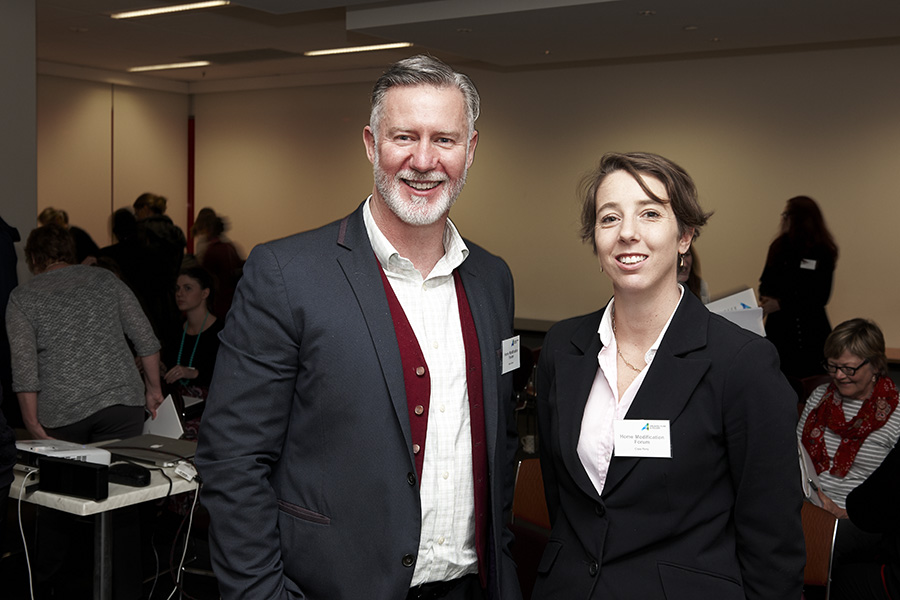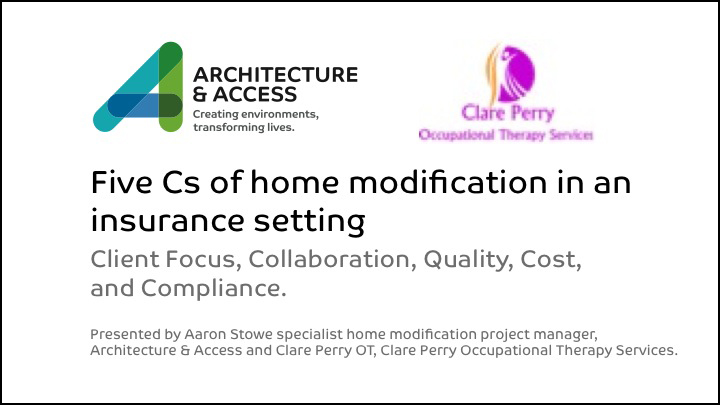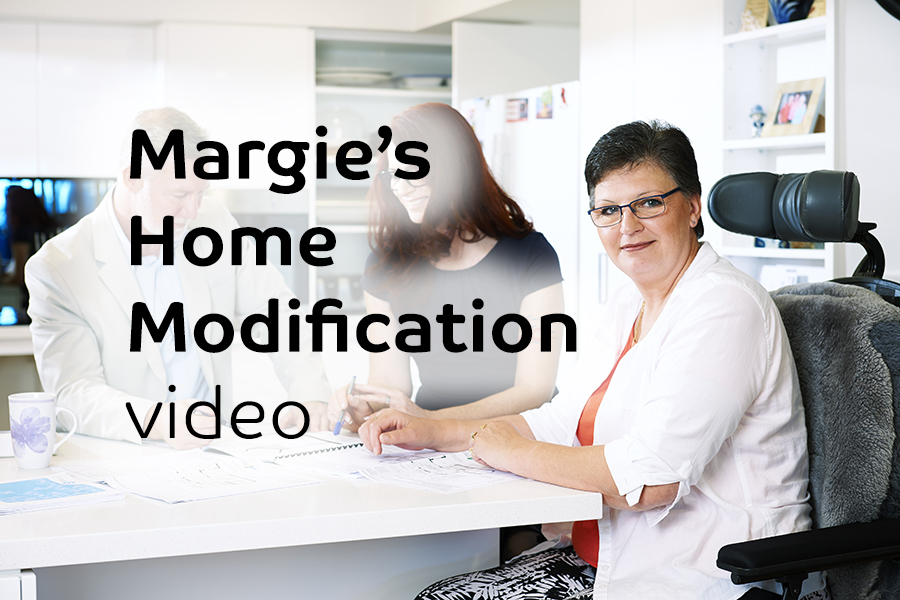Collaboration, client focus and quality were key themes as OTs and project managers from across the home modification sector discussed current opportunities and challenges facing professionals working in the insurance environment.
Architecture & Access director Chris Porter welcomed the passionate group of multi-disciplinary professionals keen to talk about the issues impacting home modification service development and delivery.
“The home modification sector is undergoing a transformation brought on by rollout of the NDIS,” he told the forum. “It is time for us to review our knowledge, respond to the changing environment and have our say about how the sector should evolve.”

Aaron Stowe and Clare Perry delivered the opening presentation, using a case study of ‘Margie’s Home Modification’ to look at five key areas impacting on home modification delivery. The presentation illustrated how practice standards may be applied to home modification delivery in areas of Client Focus, Collaboration, Compliance, Cost and Quality. A PDF transcript of the presentation is available below.
Panel discussion
The panel discussion featured leading specialists from the home modification sector presenting a range of perspectives on opportunities and challenges for OTs and project managers operating in the insurance environment.
Bronwyn Stephen, a senior occupational therapist and manager of Quality Lifestyle Solutions – Occupational Therapy in Action, and recently appointed co-convenor of the OT Australia’s Home Modifications Special Interest Group expressed concern for the enormous challenge facing OTs due to the recent closure of Archicentre.
“Our focus as OTs is on the person. We are assessing the implications of their medical problems both short and long term, looking at their cognitive state, any issues they may have in terms of depression or anxiety, the family situation.”
“We have to look at how that physical environment is modified, including the prescribing of equipment, to match the person’s needs and come up with the best solution. For the client, the solution must be achievable, fundable, and have a positive outcome,” she said.
“Considering different options for the design and construction aspects of a home modification by ourselves, without input from an architect, is going to be very challenging because we are not the design or construction experts.”
David Brown, Architecture & Access Home Modifications Unit Manager said that project managers have a key role to play, taking the lead on the design and specification of home modification along with compliance, cost, and quality control in the overall project delivery.
“We see our role as essential in any insurance project for people with severe and permanent disability living in a home that presents significant barriers to independence.”
“We work collaboratively with the OT and the person with the disability to come up with the best solution — whether the home requires a ramp, a new bathroom and toilet, creating an accessible kitchen, laundry, or paths of travel to any other spaces or outdoor areas right up to the custom home design incorporating specialised equipment and adaptive technology,” he said.
David called for greater clarity in the process of referral, so OTs know when and how to involve a project manager to assist them.
Ken Anderson, Injury Management Advisor Worker’s Compensation and home modification subject matter expert at CGU Insurance raised a number of issues that impacted the initiation of home modification projects from the perspective of the insurance agent. These included the complex process of determining the worker’s eligibility for home modification, the requirement to ensure the the best outcome for the most reasonable price, and to determine the best solution compared to other options.
“We are highly reliant on the reports that come in from the OTs, which we then assess and apply the insurer’s framework to decide what will actually be approved to fund,” he said. “Unfortunately, at the moment, some OTs are progressing the process to some extent before it gets to us, so we need to be looking at ways to improve the initial stage.”
Ken proposed that greater clarity about the role of the insurance agent, more hands-on involvement and collaboration with the OT and the project manager, and general timeliness were areas of opportunity for agents.
Michael Bleasdale, CEO of MODA Home Modifications Australia, pointed to the need for evidence in relation to best practice in home modification.
“One of the key activities of MODA is the development of a quality standard capable of increasing our knowledge about what constitutes good practice in areas of client focus, design, construction and so forth,” he said. “A quality standard would also form the basis for home modification service providers to be accredited for aged care, disability, community care, across the range of different program areas.”
“A quality standard should also take into account the best way of procuring and administering home modification services to deliver better outcomes.”
Michael observed that state-based and program-based differences were a major source of stress for professional due to the enormous variation of approaches and costs for home modifications across a disparate number of unconnected programs across the country.
“MODA hopes to coordinate a more consolidated home modification industry, then to be able to get in the door and around the table much earlier with policy-makers and government departments when reforms are taking place and under review.”
The forum opened up to a keen discussion on a range of issues raised by participants.
Concluding remarks
In conclusion, Chris Porter urged all players to support each other and the wider home modification sector as a unique and valuable industry undergoing massive transformation, and encouraged people to unite to strongly advocate for the appropriate scoping of professional practice and appreciation of the service offerings of OTs, project managers, designers and builders.
“More work needs to done on all levels including defining the roles and scope of professional practice, service system development, research and training,” said Chris. “In the future, our industry will be identified by practice standards, requisite specialised knowledge and skillsets, and the unique products we deliver in response to the needs of people with disability.”
He proposed that the form of future services will depend on the entrepreneurial approach taken by service providers in developing new business models and upskilling through training and workforce development.
“We will need funding and advocacy to make the transition as service providers in the new marketplace,” said Chris. “Importantly, we need an evidence base to draw upon to support best practice and service development. To achieve this, we will need to lobby insurers to facilitate innovation, research and best practice in the sector.”
The strengthening of interdisciplinary networks and communication at a local, state and national level – between insurers, OTs project managers, designers and people with disability will be key to securing the success of the home modification sector and better outcomes for the consumer.
A summary of issues raised in the open forum discussion will be on made available in the near future.
Links to resources and material
.


Presenters & panelists contact information
(as pictured in title image from L-R)]
David Brown – Unit Manager Projects, Architecture & Access. Email: dbrown@architectureandaccess.com.au
Bronwyn Stephenn – Manager Quality Lifestyle Solutions and co-convenor of OT Association home modification special interest group (Vic). Email: bronwynqls@hotmail.com
Michael Bleasdale – CEO MODA Home Modification Australia. Email: ceo@moda.org.au
Aaron Stowe, Senior Home Modification Project Manager, Architecture & Access. Email: astowe@architectureandaccess.com.au
Chris Porter, Director, Architecture & Access. Email: cporter@architectureandaccess.com.au
Clare Perry, Principal, Clare Perry Occupational Therapy Solutions. Email: clareperry@occupationaltherapyservices.com.au
Ken Anderson, Injury Management Adviser and home modification subject matter expert, CGU. Email: ken.anderson@cgu.com.au
More information about OT Association home modification special interest group, please email co-convenor Bronwyn Stephen bronwynqls@hotmail.com or contact OT Australia Victoria Division on Email: info.vic@otaus.com.au
More information about MODA – Home Modification Australia website.
More information about Architecture & Access Home Modification services.
